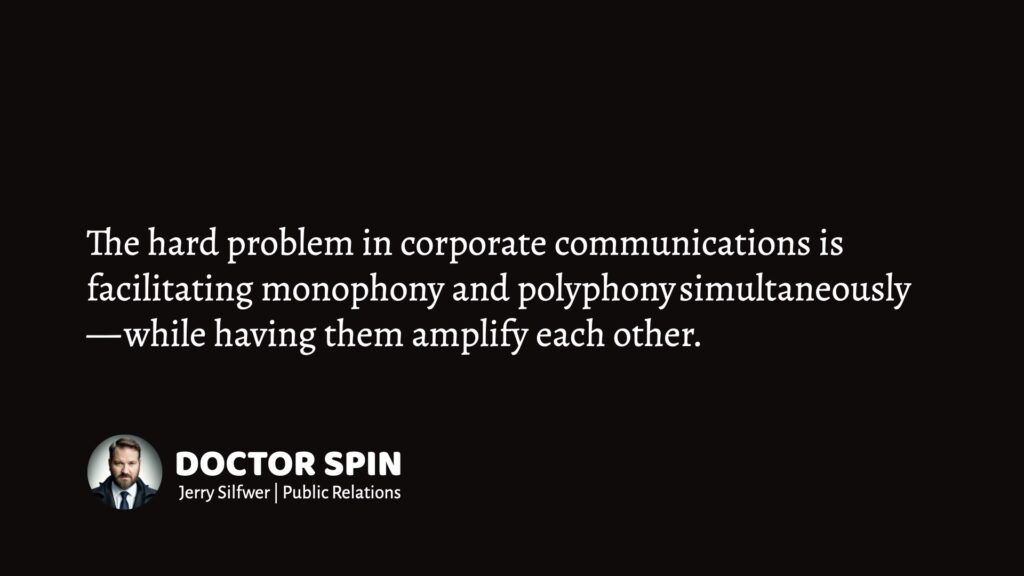Monophony and polyphony aren’t mutually exclusive.
By maintaining a clear, easy-to-understand, monophonic base and allowing for polyphonic flexibility, organisations can adjust to new trends, audience feedback, and external pressures without losing their core message or brand identity.
Here we go:
Monophony and Polyphony in Public Relations
The other day, Professor Catrin Johansson invited me to an academic briefing at Mid Sweden University, where Associate Professor Rickard Andersson from Lunds University presented new research studies. The study investigated how various public organisations conveyed their messages strategically. 1Andersson, R., Heide, M., & Simonsson, C. (2024). Slutrapport: Kommunikativa offentliga organisationer –Strategisk kommunikation som bygger relationer och förtroende. Institutionen för … Continue reading
I found one aspect of the analysis especially intriguing:
The researchers borrowed two terms from musical composition to aid their analysis: monophony and polyphony. Note that polyphony has also been used in literature analysis. 2Polyphony (literature). (2024, January 9). In Wikipedia. https://en.wikipedia.org/wiki/Polyphony_(literature) 3Mikhail Bakhtin. (2024, February 19). In Wikipedia. https://en.wikipedia.org/wiki/Mikhail_Bakhtin
Based on my understanding of these concepts, here’s how I would define them:
Monophony = when an organisation conveys strategic messaging with one voice. The monophonic approach offers numerous benefits, including narrative focus and strategic consistency.
Polyphony = when an organisation conveys strategic messaging with multiple voices. The polyphonic approach offers numerous benefits, offering authenticity multiplied through many contact surfaces.
The strengths of one approach can be characterised as the weaknesses of the other, and vice versa. At first glance, the monophonic and polyphonic approaches to public relations seem inversely correlated — at least theoretically.
In practice, the potential dichotomy isn’t apparent:
Monophony isn’t necessarily strengthened by suppressing polyphony, and vice versa. The hard problem in corporate communications is facilitating both approaches — simultaneously! — and having them amplify each other.
“One common misinterpretation seems to be that lack of monophony leads to cacophony, i.e. an organization filled with noise. However, as several researchers have argued, there is another alternative – namely, the polyphonic communication approach (Schneider & Zerfass, 2018), which gives room for the inclusion of multiple voices and the combination of “diversity and unity within a coherent entity” (Christensen et al. 2008, p. 195). The polyphonic approach comes with a decentralized structure which is a much better match to the ambition to encourage employees to engage in the organization’s communication.“
Source: EUPRERA (European Public Relations Education and Research Association 4Simonsson, C. (2021, May 7). Shifting to a polyphonic communication approach – a prerequisite for turning employees into engaged communicators. EUPRERA. … Continue reading
How can an organisation ensure both monophony and polyphony at the same time?

Learn more: Monophony and Polyphony in Public Relations
Monophonic Communication Approach
Examples of how the monophonic communication approach can strengthen corporate communication:
Examples of how the monophonic communication approach can weaken corporate communication:
Polyphonic Communication Approach
Examples of how the polyphonic communication approach can strengthen corporate communication:
Examples of how the polyphonic communication approach can weaken corporate communication:
The Core Message: Bridging the Gap
In public relations, corporate communication professionals must understand that monophonic and polyphonic approaches are not mutually exclusive but complementary elements of a robust communication strategy.
To effectively blend these approaches, professionals should designate a clear and consistent core message as the foundation of their communication strategy — the hallmark of the monophonic approach.
Core message = the fundamental idea or promise that a brand consistently communicates across all platforms, defining its values and what it stands for in every interaction with its audience. 8Silfwer, J. (2024, May 2). The Core Message. Doctor Spin | The PR Blog. https://doctorspin.net/core-message/
Different departments or representatives can offer unique interpretations or supplementary messages around this core message, echoing the polyphonic model. This strategy ensures that while the organisation’s primary objectives and values are clearly communicated and remain undiluted, there is also space for individuality and personal engagement with the audience. This can be particularly effective in large organisations where different divisions may have distinct cultures but must align under a single corporate umbrella.
This strategic synergy amplifies corporate communication’s effectiveness and builds a more engaged and committed workforce.

THANKS FOR READING.
Need PR help? Hire me here.

What should you study next?
Spin Academy | Online PR Courses

Spin’s PR School: Free Corporate PR Course
Explore this Free Corporate PR Course to learn strategic communication insights and techniques and stay ahead in the competitive public relations industry.
Corporate Communications
Agency Collaboration
Corporate Messaging
Corporate Challenges
Learn more: All Free PR Courses
💡 Subscribe and get a free ebook on how to get better PR.

Annotations
| 1 | Andersson, R., Heide, M., & Simonsson, C. (2024). Slutrapport: Kommunikativa offentliga organisationer – Strategisk kommunikation som bygger relationer och förtroende. Institutionen för strategisk kommunikation, Lunds universitet. |
|---|---|
| 2 | Polyphony (literature). (2024, January 9). In Wikipedia. https://en.wikipedia.org/wiki/Polyphony_(literature) |
| 3 | Mikhail Bakhtin. (2024, February 19). In Wikipedia. https://en.wikipedia.org/wiki/Mikhail_Bakhtin |
| 4 | Simonsson, C. (2021, May 7). Shifting to a polyphonic communication approach – a prerequisite for turning employees into engaged communicators. EUPRERA. https://euprera.org/2021/05/07/shifting-to-a-polyphonic-communication-approach-a-prerequisite-for-turning-employees-into-engaged-communicators/ |
| 5 | Silfwer, J. (2020, April 21). The Content Themes PR Strategy: The Power of Focus. Doctor Spin | The PR Blog. https://doctorspin.net/content-themes-pr-strategy/ |
| 6 | Silfwer, J. (2021, May 15). Social Media Algorithms and How They Rule Our Lives. Doctor Spin | The PR Blog. https://doctorspin.net/social-media-algorithms/ |
| 7 | Silfwer, J. (2016, May 25). The Follower Contract. Doctor Spin | The PR Blog. https://doctorspin.net/follower-contract/ |
| 8 | Silfwer, J. (2024, May 2). The Core Message. Doctor Spin | The PR Blog. https://doctorspin.net/core-message/ |


